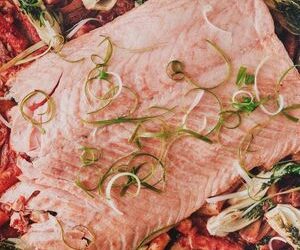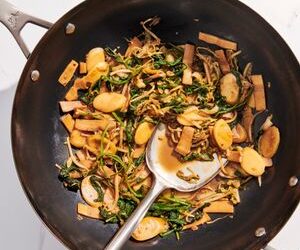[Photographs: Gina DePalma]
As wonderful as it is to bite into the tender, juicy fresh figs that are in season right this minute, I’m still devoted to the dried figs I always keep on hand, at home and in the Babbo kitchen. The chewy exterior gives way to the honey-sweet innards that make it oh so hard to eat just one. In cooking and baking, dried figs are endlessly versatile, retaining their texture and harmonizing nicely with salty, tangy, or fatty flavors. You can toss them into stews or risotto, roast them with meat or poultry, and bake them into any number of sweet treats.
I think most Italian-Americans like myself have a close relationship with dried figs, since figs were undoubtedly one of the things our parents and grandparents longed for when they found themselves so far from sunny Italy. Fig trees grow rampant in most southern regions of Italy and on the islands of Sicily, Pantelleria, and Sardinia, where it is not uncommon to pull your car along the side of a road to pluck a juicy fig from an offering branch. Figs that are not consumed fresh are dried naturally in the intense heat of the sun, concentrating the natural sugars and intensifying the flavor.
Like olives, the fruit of the fig tree has historical, religious, and mythological significance as well, depicted in classical works of art and a character in ancient lore. Some branches of early Christianity recognized the fig, instead of an apple, as the forbidden fruit offered to Adam by Eve. Romulus and Remus, the founders of Rome, were suckled by the she-wolf under a fig tree, and Siddhartha is said to have experienced the revelations that were to become the foundations of Buddhism while resting under a fig tree. The Greeks believed figs to be an antidote for all ailments, and in Rome, Pliny the Elder heralded figs as restorative, urging that they be fed to the weak and sick to forge a path to recovery and reverse the effects of aging. The original Olympians were crowned with wreaths of fig leaves, and feasted on the fruit to celebrate their victories.
My maternal grandmother taught me how to celebrate with figs, too. She always kept a cache of her baked and nut-stuffed figs close at hand, ready to be pulled out to enjoy after dinner with cheese or coffee. Dried figs from Sicily were her choice because they were the most plump and moist. She stuffed them with walnuts or almonds, baked them gently, and stored her gems in a recycled tin coffee can with the peel of an apple to help preserve the texture.
That flavor combination still beguiles me to this day, and my Fig and Almond Cookies are the result. They are like a mini food tour of Sicily, made from chopped dried figs and toasty almonds, and flavored with the brightness of a fresh orange. If you can’t find Sicilian figs, golden Calimyrna figs from California are the next best choice. Plumping them first makes the figs easy to chop in a food processor and helps to ease them into the dough. Try these with a steaming cup of tea.






